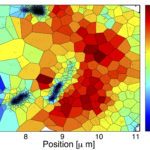Lien vers Pubmed [PMID] – 27627329
Phys Rev E 2016 Aug;94(2-1):022401
We describe how a single-particle tracking experiment should be designed in order for its recorded trajectories to contain the most information about a tracked particle’s diffusion coefficient. The precision of estimators for the diffusion coefficient is affected by motion blur, limited photon statistics, and the length of recorded time series. We demonstrate for a particle undergoing free diffusion that precision is negligibly affected by motion blur in typical experiments, while optimizing photon counts and the number of recorded frames is the key to precision. Building on these results, we describe for a wide range of experimental scenarios how to choose experimental parameters in order to optimize the precision. Generally, one should choose quantity over quality: experiments should be designed to maximize the number of frames recorded in a time series, even if this means lower information content in individual frames.

